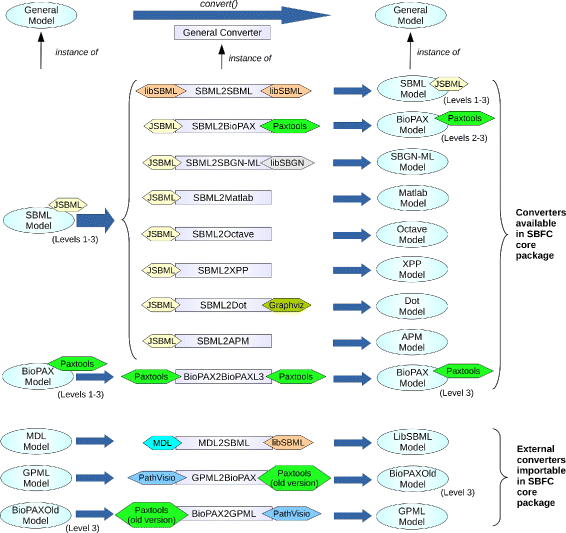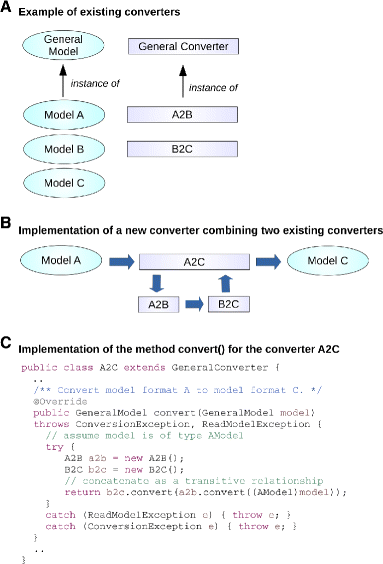Journal:The systems biology format converter
| Full article title | The systems biology format converter |
|---|---|
| Journal | BMC Bioinformatics |
| Author(s) |
Rodriguez, N.; Pettit, J.-B.; Pezze, P.D.; Li, L.; Henry, A.; van Iersel, M.P.; Jalowicki, G.; Kutmon, M.; Natarajan, K.N.; Tolnay, D.; Stefan, M.I.; Evelo, C.T.; Le Novère, N. |
| Author affiliation(s) |
EMBL European Bioinformatics Institute, The Babraham Institute, Maastricht University, California Institute of Technology |
| Primary contact | E-mail: lenov@babraham.ac.uk |
| Year published | 2016 |
| Volume and issue | 17 |
| Page(s) | 154 |
| DOI | 10.1186/s12859-016-1000-2 |
| ISSN | 1471-2105 |
| Distribution license | Creative Commons Attribution 4.0 International |
| Website | http://bmcbioinformatics.biomedcentral.com/articles/10.1186/s12859-016-1000-2 |
| Download | http://bmcbioinformatics.biomedcentral.com/track/pdf/10.1186/s12859-016-1000-2 (PDF) |
Abstract
Background
Interoperability between formats is a recurring problem in systems biology research. Many tools have been developed to convert computational models from one format to another. However, they have been developed independently, resulting in redundancy of efforts and lack of synergy.
Results
Here we present the System Biology Format Converter (SBFC), which provide a generic framework to potentially convert any format into another. The framework currently includes several converters translating between the following formats: SBML, BioPAX, SBGN-ML, Matlab, Octave, XPP, GPML, Dot, MDL and APM. This software is written in Java and can be used as a standalone executable or web service.
Conclusions
The SBFC framework is an evolving software project. Existing converters can be used and improved, and new converters can be easily added, making SBFC useful to both modellers and developers. The source code and documentation of the framework are freely available from the project web site.
Keywords
Converter, Format, Systems biology, SBML
Background
Computational representations of pathways and models lie at the core of systems biology research.[1] Formats have been designed to encode these complex knowledge representations, either as community standards or as formats specific to a software tool.[2] Different formats are preferentially used to address specific problems or use different approaches, thus limiting interoperability. However, one often needs to use several tools and approaches to answer a biological question, or to reuse existing pathways and models in different contexts. Many format converters have been written over the years. Often, several converters between the same formats are developed independently by different groups. This results in a duplication of efforts and waste of time, energy and money. The different converters may be inconsistent, leading to different results. In addition, being developed by one person or one team, those software tools tend to go unmaintained while the formats they are covering keep evolving. Finally, some of these converters are embedded in larger pieces of software, which hinders their use.
To overcome these challenges, the Systems Biology Format Converter (SBFC) software provides an open-source modular and extensible framework to potentially support conversion between any two formats using a single executable or web service.
Implementation
SBFC was built to support rapid implementation and integration of new converters. Therefore, it was designed with a high degree of modularity. At the core of the software are the GeneralModel interface and the GeneralConverter abstract class. The former is used for data exchange and describes the operations that every input or output format object must implement to be processed by SBFC. The latter represents the generic algorithm for converting one format into another. An overview of the SBFC framework is provided on Fig. 1.
|
To add a new format, a developer must simply implement the GeneralModel interface, which provides some methods to read and write the format to file or string. Adding a new converter requires extending the GeneralConverter class and implementing the GeneralModel convert(GeneralModel model) method, where the model parameter is the input format that needs to be converted and the returned GeneralModel object is the new converted format. For instance a converter A2B translating from a file formatted as model A to a file formatted as model B requires the definition of two classes ModelA and ModelB implementing the GeneralModel interface. The class converter A2B must extend the abstract class GeneralConverter and implement the method GeneralModel convert(GeneralModel model). This method will receive an input object named model, whose dynamic type is ModelA. The object returned by this method will have dynamic type ModelB.
Because all SBFC format classes are implementations of the GeneralModel interface, it is possible to create new converters re-using existing converters by simply invoking the generic convert() method for each existing converter (Fig. 2). The convert() method in the new converter A2C is implemented by calling the convert() methods in the converters A2B and B2C, respectively (source code for all classes is available in the SBFC manual).
|
SBFC is developed using the Java programming language. However, if an existing converter is developed in a programming language other than Java, it is still possible to create a new SBFC converter that will invoke the existing converter using the Java Runtime exec() method. This approach can be used for invoking any external program or command without having to re-write the full converter. Once the converter is integrated into the framework, it can be used and combined effortlessly with other converters (source code available in the SBFC manual). A potential disadvantage of this approach is the loss of interoperability when using operating system-dependent code. The advantage is that the specific SBFC converters directly rely on the development of the original external converters reducing code duplication.
Each format is identified by an identifiers.org URI[3] or an internet media type. If none of them exists, the developers of the format and converter classes must agree on an identifier (URI) for this format. SBFC allows multiple classes implementing the GeneralModel interface for a given format, using different tools to read and write models. All classes should return the same value for the getURI() method. For instance, the implementation of a converter for the Systems Biology Markup Language[4] may rely on JSBML[5], libSBML[6], or a DOM document structure.[7] This design can be advantageous when 1) a given library does not read a version of a format properly; 2) a converter was written with an old or newer version of a library that has a different API; or 3) high performance is required (e.g. improving the implementation for file processing). At the beginning of a conversion, the converter checks that the value returned by the getURI() method of the input GeneralModel is a URI of a format it does support. If the converter recognises the format URI, the generic write methods (modelToString() or modelToFile(String fileName)) are used in order to retrieve the file content.
Results
Available formats and converters
The SBFC project already implemented support for several formats and developed several converters. The following format classes are provided:
- APMModel for the APMonitor Modelling Language (APM). APMonitor is an optimization software for mixed-integer and differential algebraic equations[8];
- BioPAXModel for BioPax, format to exchange descriptions of biomolecular pathways, including reaction and interaction networks[9];
- DotModel for the Dot format, that encodes graph descriptions used by the open source graph visualisation software GraphViz[10] to generate multiple image formats (e.g. PNG, JPEG, etc);
- GPMLModel for the format used by the pathway drawing and analysis tool PathVisio[11] and the pathway database WikiPathways[12];
- MDLModel for the format used by the single particle simulator MCell[13];
- OctaveModel for Octave and MatLab m-file formats, encoding mathematical models usable by the modeling environments GNU Octave[14] and MatLab;
- SBGNMLModel for SBGN-ML format, a format to encode graphical maps in the Systems Biology Graphical Notation[15];
- SBMLModel for SBML[4], a format encoding mathematical models;
- XPPModel for XPP format, encoding mathematical models usable by the numerical analysis software XPPAUT.[16]
This core set of model formats was based on the set of converters internally used by the BioModels project.[17] As SBML is central for this resource, the focus was on implementing converters from SBML to other formats. The following converters listed by class name are currently available: SBML2SBML, SBML2APM, SBML2BioPAX, SBML2SBGNML, SBML2Matlab, SBML2Octave, SBML2XPP, SBML2Dot. SBFC also supports conversions between SBML model annotations urn:miriam[18] and Identifiers.org URL[3] with the converters URN2URL and URL2URN. The Systems Biology community has been developing additional converters, including MDL2SBML, GPML2BioPAX, BioPAX2BioPAXL3 (converting from BioPAX Level 1 and 2 to BioPAX Level 3).
References
- ↑ Le Novère, N. (2015). "Quantitative and logic modelling of gene and molecular networks". Nature Reviews Genetics 16 (3): 146–158. doi:10.1038/nrg3885. PMC PMC4604653. PMID 25645874. https://www.ncbi.nlm.nih.gov/pmc/articles/PMC4604653.
- ↑ Hucka, M., Nickerson, D.P.; Bader, G.D. et al. (2015). "Promoting coordinated development of community-based information standards for modeling in biology: The COMBINE initiative". Frontiers in Bioengineering and Biotechnology 3: 19. doi:10.3389/fbioe.2015.00019. PMC PMC4338824. PMID 25759811. https://www.ncbi.nlm.nih.gov/pmc/articles/PMC4338824.
- ↑ 3.0 3.1 Juty, N.; Le Novère, N.; Laibe, C. (2012). "Identifiers.org and MIRIAM Registry: Community resources to provide persistent identification". Nucleic Acids Research 40 (D1): D580-D586. doi:10.1093/nar/gkr1097. PMC PMC3245029. PMID 22140103. https://www.ncbi.nlm.nih.gov/pmc/articles/PMC3245029.
- ↑ 4.0 4.1 Hucka, M.; Finney, A.; Sauro, H.M. et al. (2003). "The systems biology markup language (SBML): A medium for representation and exchange of biochemical network models". Bioinformatics 19 (4): 524-531. doi:10.1093/bioinformatics/btg015. PMID 12611808.
- ↑ Dräger, A.; Rodriguez, N.; Dumousseau, M. et al. (2011). "JSBML: A flexible Java library for working with SBML". Bioinformatics 27 (15): 2167-2168. doi:10.1093/bioinformatics/btr361. PMC PMC3137227. PMID 21697129. https://www.ncbi.nlm.nih.gov/pmc/articles/PMC3137227.
- ↑ Bornstein, B.J.; Keating, S.M.; Jouraku, A.; Hucka, M. (2008). "LibSBML: an API library for SBML". Bioinformatics 24 (6): 880-881. doi:10.1093/bioinformatics/btn051. PMC PMC2517632. PMID 18252737. https://www.ncbi.nlm.nih.gov/pmc/articles/PMC2517632.
- ↑ Le Hors, A.; Le Hégaret, P.; Wood, L. et al. (2004). "Document Object Model (DOM) Level 3 Core Specification". W3C. https://www.w3.org/TR/DOM-Level-3-Core/. Retrieved 14 March 2016.
- ↑ Hedengren, J.D.; Asgharzadeh, S.R.; Powell, K.M.; Edgar, T.F. (2014). "Nonlinear Modeling, Estimation and Predictive Control in APMonitor". Computers & Chemical Engineering 70: 133–148. doi:10.1016/j.compchemeng.2014.04.013.
- ↑ Demir, E.; Cary, M.P.; Paley, S. et al. (2010). "The BioPAX community standard for pathway data sharing". Nature Biotechnology 28 (9): 935–942. doi:10.1038/nbt.1666.
- ↑ Gansner, E.R.; North, S.C. (2000). "An open graph visualization system and its applications to software engineering". Software: Practice and Experience 30 (11): 1203–1233. doi:10.1002/1097-024X(200009)30:11<1203::AID-SPE338>3.0.CO;2-N.
- ↑ Van Iersel, M.P.; Kelder, T.; Pico, A.R. et al. (2008). "Presenting and exploring biological pathways with PathVisio". BMC Bioinformatics 9: 399. doi:10.1186/1471-2105-9-399. PMC PMC2569944. PMID 18817533. https://www.ncbi.nlm.nih.gov/pmc/articles/PMC2569944.
- ↑ Pico, A.R.; Kelder, T.; Van Iersel, M.P. et al. (2008). "WikiPathways: Pathway editing for the people". PLoS Biology 6 (7): e184. doi:10.1371/journal.pbio.0060184. PMC PMC2475545. PMID 18651794. https://www.ncbi.nlm.nih.gov/pmc/articles/PMC2475545.
- ↑ Stiles, J.R.; Bartol, T.M. (2000). "Chapter 4. Monte Carlod Methods for Simulating Realistic Synaptic Microphysiology Using MCell". In De Schutter, E.. Computational Neuroscience: Realistic Modeling for Experimentalists. CRC Press. doi:10.1201/9781420039290.ch4. ISBN 9781420039290.
- ↑ Eaton, J.W. (2015). "GNU Octave". Free Software Foundation, Inc. http://www.gnu.org/software/octave/doc/interpreter/. Retrieved 14 March 2016.
- ↑ Le Novère, N.; Hucka, M.; Mi, H. et al. (2009). "The Systems Biology Graphical Notation". Nature Biotechnology 27 (8): 735-741. doi:10.1038/nbt.1558. PMID 19668183.
- ↑ Ermentrout, B. (2002). Simulating, Analyzing, and Animating Dynamical Systems: A Guide to XPPAUT for Researchers and Students. Society for Industrial and Applied Mathematics. pp. 298. doi:10.1137/1.9780898718195. ISBN 9780898718195.
- ↑ Le Novère, N.; Bornstein, B.; Broicher, A. et al. (2006). "BioModels Database: A free, centralized database of curated, published, quantitative kinetic models of biochemical and cellular systems". Nucleic Acids Research 34 (Suppl 1): D689-D691. doi:10.1093/nar/gkj092. PMC PMC1347454. PMID 16381960. https://www.ncbi.nlm.nih.gov/pmc/articles/PMC1347454.
- ↑ Le Novère, N.; Finney, A.; Hucka, M. et al. (2005). "Minimum Information Required In the Annotation of Models (MIRIAM)". Nature Biotechnology 23 (12): 1509-1515. doi:10.1038/nbt1156. PMID 16333295.
Notes
This presentation is faithful to the original, with only a few minor changes to presentation. In some cases important information was missing from the references, and that information was added.











